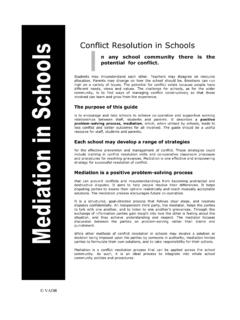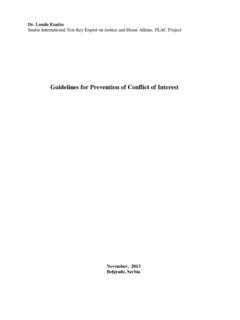Transcription of Negotiation - Conflict Resolution Network
1 No fee required to reproduce this page if this notice appears: The Conflict Resolution Network PO Box 1016 Chatswood NSW 2057 Australia Ph. 61 2 9419 8500 Fax 61 2 9413 1148 Email: Web: Negotiation Negotiation Objectives: To explore key skills and the structure of Negotiation . To practise Negotiation skills. Session Times: 3 hours: Sections A H 2 hours: Sections B E, H 1 hour: Sections B C Essential Background: The Win/Win Approach Sections: A. Stimulus Activity B. Exploring the Concept of Negotiation C.
2 The Phases and Skills of a Negotiation D. Responding to Resistance from Others E. Opening a Negotiation F. Using DISC to Understand Negotiation Styles G. Responding to "Unfair" Tactics H. Practising Negotiation Activities: Buying and Selling Opening a Negotiation Negotiation in Practice Handouts: Section C: The Skills of Negotiation Section E: Thirty Second Opener Section F: Disc Negotiation Styles Worksheet fee required to reproduce this page if this notice appears: The Conflict Resolution Network PO Box 1016 Chatswood NSW 2057 Australia Ph.
3 61 2 9419 8500 Fax 61 2 9413 1148 Email: Web: Negotiation Section G: Strategies for Responding to Unfair Tactics Responding to Unfair Tactics Section H: Negotiation : Preparation Phase No fee required to reproduce this page if this notice appears: The Conflict Resolution Network PO Box 1016 Chatswood NSW 2057 Australia Ph. 61 2 9419 8500 Fax 61 2 9413 1148 Email: Web: Negotiation Negotiation Creating Suitable Environments for Working Together Towards Resolution A. Stimulus Activity Group Activity: Buying and Selling: working in pairs, one as buyer and one as seller, participants negotiate the price of a car.
4 (See Negotiation Activities, p ) (20 minutes) B. Exploring the Concept of Negotiation (10 minutes) Question: What do we understand by the term '' Negotiation ''? Discussion: Encourage a few minutes' discussion to arrive at a common understanding of the term. '' Negotiation involves two (or more) parties with competing or conflicting interests or needs, working towards an agreement on how they will co-operate'' Dr Gregory Tillett Resolving Conflict (Sydney: Sydney University Press, 1991) p46.
5 Question: Think of some recent negotiations in which you have been involved. What are they? Discussion: Draw out participants' responses. In addition, you might list: buying a car, a house or an appliance negotiating a new salary package negotiating different roles and responsibilities at work arranging a fair division of household chores making divorce settlements and custody arrangements agreeing with a child (or a parent) on a study schedule or what time to be home. Question: Why do we negotiate in these settings? Discussion: Draw out participants' responses.
6 In addition, you might consider: variety of reasons depending on the situation there seems to be no alternative (people may not otherwise be willing to shift) to reach agreement to maintain or strengthen the relationship to be fair; to take account of both parties' perspectives, needs and concerns to get the best deal possible. Question: In what ways is our style of negotiating different depending on the situation? Discussion: Draw out participants' responses. In addition, you might consider: we often tend to be more open in our negotiations when there is a high level of trust, when the continuance of the relationship is seen as important, and when there seems to be many options available ( negotiating task divisions amongst people with whom we either work or live) we often tend to be less open when there is little trust, when we are not overly concerned about the relationship, and when there seems to be few options available ( buying and selling a car).
7 In this course, we're going to focus on an approach to Negotiation that is built within a win/win framework. Question: What do you think a win/win approach to Negotiation would involve? Discussion: Draw out participants' responses. Make sure the following is included: A win/win approach to Negotiation takes account of the many needs of the parties involved. This approach is sometimes known as interest-based bargaining. Roger Fisher & William Ury in Getting to Yes (London: Business Books 1981) identify it as ''principled Negotiation or Negotiation on the merits (p11).
8 This can be understood as a process which seeks to meet needs or interests; not to win positions or to gain victories for people. It's very different to positional bargaining in which each side takes a position argues for it and at best, makes concessions to reach a compromise. Fisher and Ury (ibid. p11) identify four main points to define this method of Negotiation . (See over.) Write on the board: Separate the people from the problem Focus on interests, not positions Generate many options Use objective standards No fee required to reproduce this page if this notice appears: The Conflict Resolution Network PO Box 1016 Chatswood NSW 2057 Australia Ph.
9 61 2 9419 8500 Fax 61 2 9413 1148 Email: Web: Negotiation In this session, we'll identify the skills which help to put these principles into practice. C. The Phases and Skills of a Negotiation (35 minutes) For a Negotiation to be successful resulting in agreements to which people feel committed, we need to take account of the range of people's needs. These needs will be both tangible and intangible. Draw and write on the board: SATISFACTION TRIANGLE The Satisfaction Triangle above is adapted from CDR Associates: Papers from " Negotiation and Mediation.
10 They Won't Cost the Earth'' a seminar held in Sydney, Australia, 10 October 1990. Substantive needs refer to tangible needs for money, time, goods, resources, territory, products etc. Procedural needs are those that relate to specific types of procedures and behaviours, ''the way something is done". Psychological/Relationship needs are those that refer to how people feel, how they want to be treated and the conditions for the on-going relationship. Concern for all these needs provides us with a win/win framework for the Negotiation . It can be useful to think of a Negotiation proceeding through three phases.







